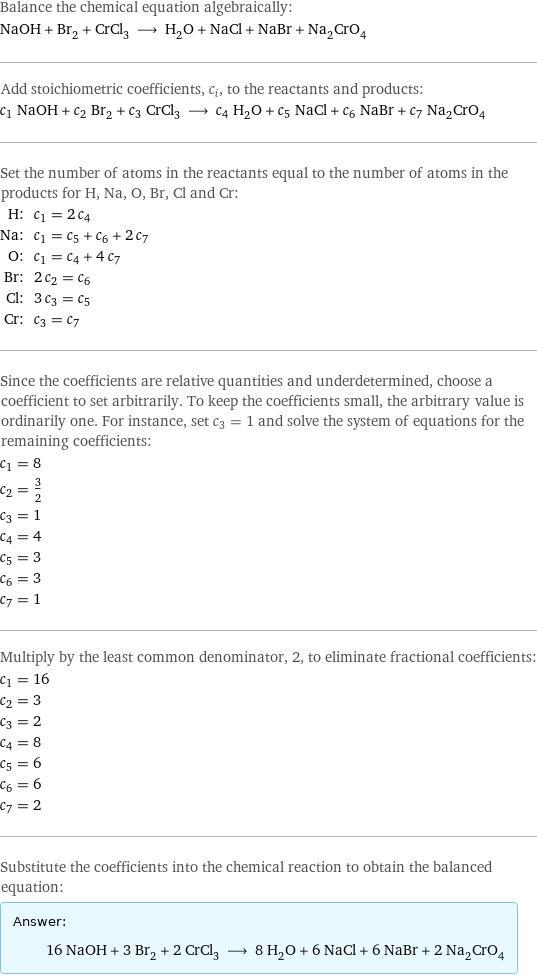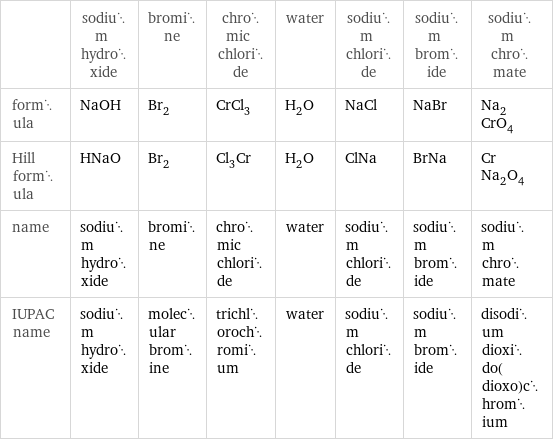Input interpretation

NaOH sodium hydroxide + Br_2 bromine + CrCl_3 chromic chloride ⟶ H_2O water + NaCl sodium chloride + NaBr sodium bromide + Na_2CrO_4 sodium chromate
Balanced equation

Balance the chemical equation algebraically: NaOH + Br_2 + CrCl_3 ⟶ H_2O + NaCl + NaBr + Na_2CrO_4 Add stoichiometric coefficients, c_i, to the reactants and products: c_1 NaOH + c_2 Br_2 + c_3 CrCl_3 ⟶ c_4 H_2O + c_5 NaCl + c_6 NaBr + c_7 Na_2CrO_4 Set the number of atoms in the reactants equal to the number of atoms in the products for H, Na, O, Br, Cl and Cr: H: | c_1 = 2 c_4 Na: | c_1 = c_5 + c_6 + 2 c_7 O: | c_1 = c_4 + 4 c_7 Br: | 2 c_2 = c_6 Cl: | 3 c_3 = c_5 Cr: | c_3 = c_7 Since the coefficients are relative quantities and underdetermined, choose a coefficient to set arbitrarily. To keep the coefficients small, the arbitrary value is ordinarily one. For instance, set c_3 = 1 and solve the system of equations for the remaining coefficients: c_1 = 8 c_2 = 3/2 c_3 = 1 c_4 = 4 c_5 = 3 c_6 = 3 c_7 = 1 Multiply by the least common denominator, 2, to eliminate fractional coefficients: c_1 = 16 c_2 = 3 c_3 = 2 c_4 = 8 c_5 = 6 c_6 = 6 c_7 = 2 Substitute the coefficients into the chemical reaction to obtain the balanced equation: Answer: | | 16 NaOH + 3 Br_2 + 2 CrCl_3 ⟶ 8 H_2O + 6 NaCl + 6 NaBr + 2 Na_2CrO_4
Structures

+ + ⟶ + + +
Names

sodium hydroxide + bromine + chromic chloride ⟶ water + sodium chloride + sodium bromide + sodium chromate
Equilibrium constant
![Construct the equilibrium constant, K, expression for: NaOH + Br_2 + CrCl_3 ⟶ H_2O + NaCl + NaBr + Na_2CrO_4 Plan: • Balance the chemical equation. • Determine the stoichiometric numbers. • Assemble the activity expression for each chemical species. • Use the activity expressions to build the equilibrium constant expression. Write the balanced chemical equation: 16 NaOH + 3 Br_2 + 2 CrCl_3 ⟶ 8 H_2O + 6 NaCl + 6 NaBr + 2 Na_2CrO_4 Assign stoichiometric numbers, ν_i, using the stoichiometric coefficients, c_i, from the balanced chemical equation in the following manner: ν_i = -c_i for reactants and ν_i = c_i for products: chemical species | c_i | ν_i NaOH | 16 | -16 Br_2 | 3 | -3 CrCl_3 | 2 | -2 H_2O | 8 | 8 NaCl | 6 | 6 NaBr | 6 | 6 Na_2CrO_4 | 2 | 2 Assemble the activity expressions accounting for the state of matter and ν_i: chemical species | c_i | ν_i | activity expression NaOH | 16 | -16 | ([NaOH])^(-16) Br_2 | 3 | -3 | ([Br2])^(-3) CrCl_3 | 2 | -2 | ([CrCl3])^(-2) H_2O | 8 | 8 | ([H2O])^8 NaCl | 6 | 6 | ([NaCl])^6 NaBr | 6 | 6 | ([NaBr])^6 Na_2CrO_4 | 2 | 2 | ([Na2CrO4])^2 The equilibrium constant symbol in the concentration basis is: K_c Mulitply the activity expressions to arrive at the K_c expression: Answer: | | K_c = ([NaOH])^(-16) ([Br2])^(-3) ([CrCl3])^(-2) ([H2O])^8 ([NaCl])^6 ([NaBr])^6 ([Na2CrO4])^2 = (([H2O])^8 ([NaCl])^6 ([NaBr])^6 ([Na2CrO4])^2)/(([NaOH])^16 ([Br2])^3 ([CrCl3])^2)](../image_source/78dcb0f376ee36904791188532930651.png)
Construct the equilibrium constant, K, expression for: NaOH + Br_2 + CrCl_3 ⟶ H_2O + NaCl + NaBr + Na_2CrO_4 Plan: • Balance the chemical equation. • Determine the stoichiometric numbers. • Assemble the activity expression for each chemical species. • Use the activity expressions to build the equilibrium constant expression. Write the balanced chemical equation: 16 NaOH + 3 Br_2 + 2 CrCl_3 ⟶ 8 H_2O + 6 NaCl + 6 NaBr + 2 Na_2CrO_4 Assign stoichiometric numbers, ν_i, using the stoichiometric coefficients, c_i, from the balanced chemical equation in the following manner: ν_i = -c_i for reactants and ν_i = c_i for products: chemical species | c_i | ν_i NaOH | 16 | -16 Br_2 | 3 | -3 CrCl_3 | 2 | -2 H_2O | 8 | 8 NaCl | 6 | 6 NaBr | 6 | 6 Na_2CrO_4 | 2 | 2 Assemble the activity expressions accounting for the state of matter and ν_i: chemical species | c_i | ν_i | activity expression NaOH | 16 | -16 | ([NaOH])^(-16) Br_2 | 3 | -3 | ([Br2])^(-3) CrCl_3 | 2 | -2 | ([CrCl3])^(-2) H_2O | 8 | 8 | ([H2O])^8 NaCl | 6 | 6 | ([NaCl])^6 NaBr | 6 | 6 | ([NaBr])^6 Na_2CrO_4 | 2 | 2 | ([Na2CrO4])^2 The equilibrium constant symbol in the concentration basis is: K_c Mulitply the activity expressions to arrive at the K_c expression: Answer: | | K_c = ([NaOH])^(-16) ([Br2])^(-3) ([CrCl3])^(-2) ([H2O])^8 ([NaCl])^6 ([NaBr])^6 ([Na2CrO4])^2 = (([H2O])^8 ([NaCl])^6 ([NaBr])^6 ([Na2CrO4])^2)/(([NaOH])^16 ([Br2])^3 ([CrCl3])^2)
Rate of reaction
![Construct the rate of reaction expression for: NaOH + Br_2 + CrCl_3 ⟶ H_2O + NaCl + NaBr + Na_2CrO_4 Plan: • Balance the chemical equation. • Determine the stoichiometric numbers. • Assemble the rate term for each chemical species. • Write the rate of reaction expression. Write the balanced chemical equation: 16 NaOH + 3 Br_2 + 2 CrCl_3 ⟶ 8 H_2O + 6 NaCl + 6 NaBr + 2 Na_2CrO_4 Assign stoichiometric numbers, ν_i, using the stoichiometric coefficients, c_i, from the balanced chemical equation in the following manner: ν_i = -c_i for reactants and ν_i = c_i for products: chemical species | c_i | ν_i NaOH | 16 | -16 Br_2 | 3 | -3 CrCl_3 | 2 | -2 H_2O | 8 | 8 NaCl | 6 | 6 NaBr | 6 | 6 Na_2CrO_4 | 2 | 2 The rate term for each chemical species, B_i, is 1/ν_i(Δ[B_i])/(Δt) where [B_i] is the amount concentration and t is time: chemical species | c_i | ν_i | rate term NaOH | 16 | -16 | -1/16 (Δ[NaOH])/(Δt) Br_2 | 3 | -3 | -1/3 (Δ[Br2])/(Δt) CrCl_3 | 2 | -2 | -1/2 (Δ[CrCl3])/(Δt) H_2O | 8 | 8 | 1/8 (Δ[H2O])/(Δt) NaCl | 6 | 6 | 1/6 (Δ[NaCl])/(Δt) NaBr | 6 | 6 | 1/6 (Δ[NaBr])/(Δt) Na_2CrO_4 | 2 | 2 | 1/2 (Δ[Na2CrO4])/(Δt) (for infinitesimal rate of change, replace Δ with d) Set the rate terms equal to each other to arrive at the rate expression: Answer: | | rate = -1/16 (Δ[NaOH])/(Δt) = -1/3 (Δ[Br2])/(Δt) = -1/2 (Δ[CrCl3])/(Δt) = 1/8 (Δ[H2O])/(Δt) = 1/6 (Δ[NaCl])/(Δt) = 1/6 (Δ[NaBr])/(Δt) = 1/2 (Δ[Na2CrO4])/(Δt) (assuming constant volume and no accumulation of intermediates or side products)](../image_source/fb18d5f79694abe503791bb334c0917f.png)
Construct the rate of reaction expression for: NaOH + Br_2 + CrCl_3 ⟶ H_2O + NaCl + NaBr + Na_2CrO_4 Plan: • Balance the chemical equation. • Determine the stoichiometric numbers. • Assemble the rate term for each chemical species. • Write the rate of reaction expression. Write the balanced chemical equation: 16 NaOH + 3 Br_2 + 2 CrCl_3 ⟶ 8 H_2O + 6 NaCl + 6 NaBr + 2 Na_2CrO_4 Assign stoichiometric numbers, ν_i, using the stoichiometric coefficients, c_i, from the balanced chemical equation in the following manner: ν_i = -c_i for reactants and ν_i = c_i for products: chemical species | c_i | ν_i NaOH | 16 | -16 Br_2 | 3 | -3 CrCl_3 | 2 | -2 H_2O | 8 | 8 NaCl | 6 | 6 NaBr | 6 | 6 Na_2CrO_4 | 2 | 2 The rate term for each chemical species, B_i, is 1/ν_i(Δ[B_i])/(Δt) where [B_i] is the amount concentration and t is time: chemical species | c_i | ν_i | rate term NaOH | 16 | -16 | -1/16 (Δ[NaOH])/(Δt) Br_2 | 3 | -3 | -1/3 (Δ[Br2])/(Δt) CrCl_3 | 2 | -2 | -1/2 (Δ[CrCl3])/(Δt) H_2O | 8 | 8 | 1/8 (Δ[H2O])/(Δt) NaCl | 6 | 6 | 1/6 (Δ[NaCl])/(Δt) NaBr | 6 | 6 | 1/6 (Δ[NaBr])/(Δt) Na_2CrO_4 | 2 | 2 | 1/2 (Δ[Na2CrO4])/(Δt) (for infinitesimal rate of change, replace Δ with d) Set the rate terms equal to each other to arrive at the rate expression: Answer: | | rate = -1/16 (Δ[NaOH])/(Δt) = -1/3 (Δ[Br2])/(Δt) = -1/2 (Δ[CrCl3])/(Δt) = 1/8 (Δ[H2O])/(Δt) = 1/6 (Δ[NaCl])/(Δt) = 1/6 (Δ[NaBr])/(Δt) = 1/2 (Δ[Na2CrO4])/(Δt) (assuming constant volume and no accumulation of intermediates or side products)
Chemical names and formulas

| sodium hydroxide | bromine | chromic chloride | water | sodium chloride | sodium bromide | sodium chromate formula | NaOH | Br_2 | CrCl_3 | H_2O | NaCl | NaBr | Na_2CrO_4 Hill formula | HNaO | Br_2 | Cl_3Cr | H_2O | ClNa | BrNa | CrNa_2O_4 name | sodium hydroxide | bromine | chromic chloride | water | sodium chloride | sodium bromide | sodium chromate IUPAC name | sodium hydroxide | molecular bromine | trichlorochromium | water | sodium chloride | sodium bromide | disodium dioxido(dioxo)chromium